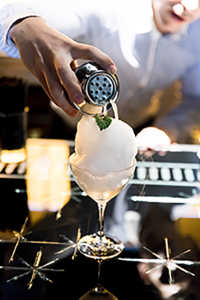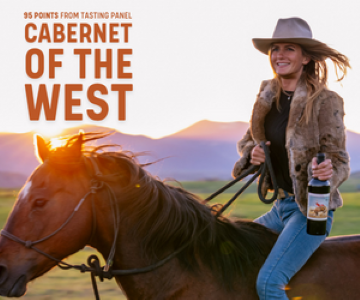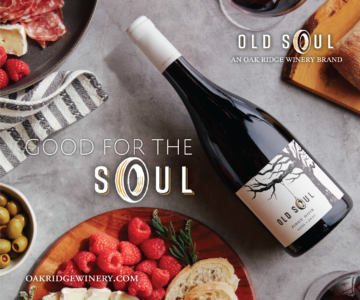story by Merrill Shindler
My attitude towards exotic cocktails has long been . . . perverse, in a non-perverse sort of way. When it comes to what I drink, I’ve long been a traditionalist. I like my Martinis bone dry, served up, perhaps with an olive floating within. And I want that olive to have pimento in it––not blue cheese or anchovy. To me, that’s an abomination in the eyes of the Lord! I’m actually so traditional, I prefer my dry Martinis made with gin, not vodka, for gin feels so much more old school. Vodka is for the arriviste, the dilettante, the sorrowful country club wannabe.
When Martinis started growing exotic a few years ago, I was moderately repulsed . . . followed by extremely repulsed, even occasionally nauseated. The bar, Lola’s, in Los Angeles, where the Orange Pucker Martini was invented, had a menu of more than a hundred Martinis. There were Chocolate Martinis. There were Mango Martinis. There were Coconut and Pineapple Martinis. By the beard of Tom Collins, these aren’t Martinis––they’re fruity drinks for kids with inappropriately permissive parents. “Drink your Froot Loops Martini, honey. It’s gonna get warm!”
I’m an old-fashioned guy who likes an Old Fashioned. A gimlet-eyed dude who enjoys a Gimlet. A man from Manhattan who sips a Manhattan. Which makes me kind of like one of those 19th century British explorers, encountering Stone Aged tribes in back of the back of the Amazon jungle, when it comes to observing the strange––and yes, wondrous––rituals of Modern Mixology, which, I should add, isn’t really modern at all. Mixology has been around for a long, long time. Indeed, all of the cocktails detailed above were the result of mixology, a long time ago. But, no big surprise, it’s all gotten a lot stranger as we’ve careened into the 21st century. I mean, really––what hasn’t?
Not only is the concept of mixology not new, but the word isn’t either. It dates back to at least 1891 when it was the title of a book with one of those great ye olde names: Cocktail Boothby’s American Bartender: The Only Practical Treatise On The Art of Mixology Published. In 1933, there was a volume titled The Mixologist, How To Mix The Makings. And for goodness’ sake, back in the Roaring Twenties, they inhaled cocktails with names like The Bees Knees (honey, gin, lemon), The Hanky Panky (gin, sweet vermouth, Fernet Branca) and The Scofflaw (rye whiskey, dry vermouth, grenadine).

There are hundreds of drinks that are long lost to history. And these days, there are hundreds more. Many of the cocktails made in this century are specific to the mixologist who makes them. (And let me also toss in that there’s been a reaction to the undeniable pretension of the word, “mixologist,” with a concomitant return to our old friend, the bartender––which really does sound much more affable. If you’re spending an elbow bending an elbow, wouldn’t you rather do it with Ralph the Bartender than Balthazar the Mixologist? Ralph will listen to your lament about life. Balthazar is too busy squeezing fresh durian juice.)
Whatever you call the current incarnation of cocktail assembler, there’s no denying that the resulting products are more exotic––and that they’re made of ingredients that will send you to your smartphone, trying to figure out what the heck it is you’re pouring down your gullet. Prices are way up there too––if the place claims a mixologist, you’re going to pay for it. Cocktails at The Grill in New York run $18 to $25. There’s a cocktail tasting menu at The Aviary in Chicago and New York, with three libations for $65. And of course, they’re not just cocktails––they’re craft cocktails.
The world of true exotica moves into a realm of Cirque du Soleil surrealism very quickly. Though once again, if you ever spent an evening hurting your liver at any of the branches of Trader Vic’s, you’ll remember drinks of many rums, and many fruit juices, arriving in massive bowls decorated with tikis and yard-long straws sticking out. They went down very easily. And often, the next morning, you had to find your driver’s license to help you remember who you were.
One of my favorite destinations for alcoholic exotica is The Bazaar by Jose Andres at SLS Beverly Hills. Partly because the cocktails are so creatively fun, partly because they really do taste extraordinary (even for a doubter like me), and partly because the prices are actually not that bad––especially considering this is a very high-end restaurant in a very high-end hotel, in Beverly Hills. The very essence of the mixology at The Bazaar is encapsulated in the Magic Mojito, which is a show, first and foremost: An oversized Martini glass arrives, piled high with cotton candy. A mixologist follows close behind, with a cocktail shaker that he uses to pour a Mojito from a moderate altitude. As the liquid hits the cotton candy, it dissolves into the glass, further flavoring the Mojito, and making drinkers at the table feel like kids in a toy store. It’s very sweet. But it’s only $18––not bad for a show and a cocktail.
For those who want to run wild, there’s the Salt Air Margarita, made with “salt air” (a mixture of textured sugar called sucro, lime juice, and kosher salt), and sal de gusano, which means “worm salt.” The Bazaar’s Manhattan is garnished with a liquid cherry sphere––classics are not always classical in the world of mixology.
But then, nothing, but nothing compares with a cocktail served at the Sourtoe Cocktail Club in the Downtown Hotel in Dawson City, Yukon. (Those with a sensitive nature might want to leave the room.) It’s called the Sourtoe Cocktail. It’s served with, yes, a preserved amputated toe in. There are no other set ingredients. It can be a mix of anything. But it’s got to have the toe in it. And the single rule is: “You can drink it fast, you can drink it slow, but the lips have got to touch the toe.”
Nobody seems to know why the drink is served, or where the toe originally came from. But an estimated 60,000 people have had it, at $6 a pop––or a toe. As mixology goes, it’s not much. As a memorable cocktail goes, it’s unforgettable.


